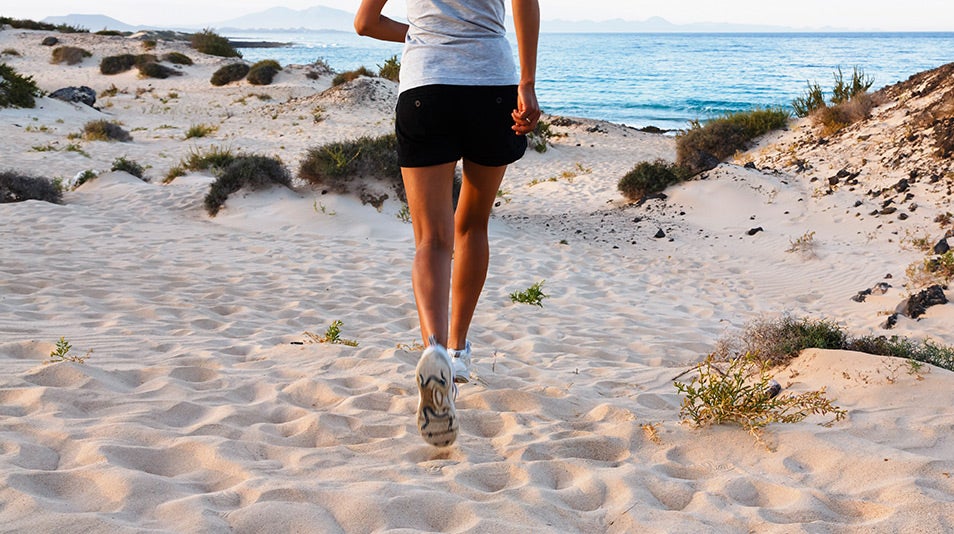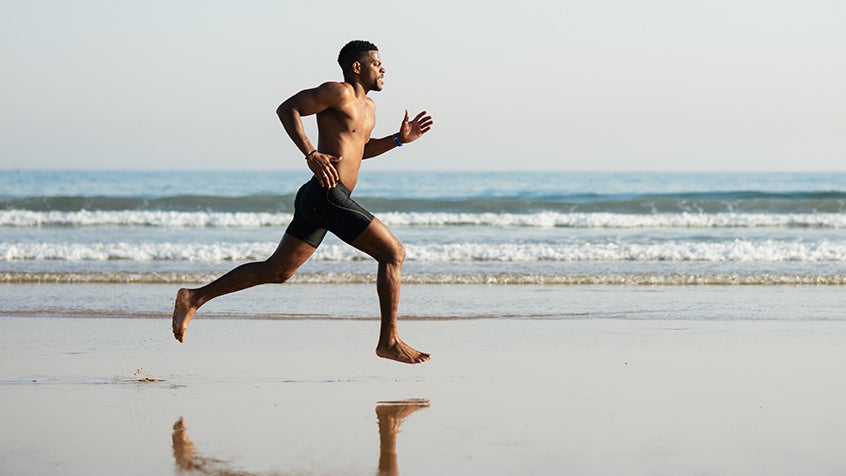20-minute soft sand workout
by Josh Wakerman on Monday 15 January 2018
5 min read
If you’ve ever gone for a soft sand run, you’ll be familiar with the killer leg burn that comes with it. And there’s reason for it – it truly does work you harder.
It's a much harder workout: It’s not rocket science; yes a soft surface requires more work from your end, but it’s also the uneven surface that makes life much harder for our leg muscles because they are constantly trying to stabilise. Because of this, we start expending much more energy.
It helps to change things up: It’s always good to change up your workouts to keep your body guessing, and soft-sand training is a great way to engage different muscles than you normally would. You’ll engage your calves and your core a bit more, and if you train barefoot, you’ll improve mobility and strengthen your feet.
Your joints can stress less: The beach is already a great place to ease the stresses of life, but your joints can enjoy a little less stress too! As your foot lands on a softer surface, you won’t be putting as much impact on your joints as you would by pounding the pavement.
So, whether you're looking for a great workout to do on your holiday, or you just want to enjoy as much sun as you can this summer, try this workout the next time you're at the beach:
The 20-minute workout
The warm up
Before you go cross country champion on us, you need to warm up. Get your heart pumping with a 5-minute shuttle. Jog forwards 10 metres, return with high knees, go back skipping, and return with walking lunges. Remember to land mid-foot rather than on your heel and propel yourself forward. Strong arm drive is fundamental for sand running (..all running, tbh) so use them to help drive your legs. You may need to shorten your strides a little, but we guarantee you'll feel it in almost straight away.
To finish, stand in one position and do a clock lunge combo – forward to 12:00, right side to 3:00, back to 6:00, left side to 9:00 - always coming back to the middle between each lunge. Again, arm movement is important for drive and balance.
The workout
Find a space on a relatively flat surface - if your beach has a slope it might be best to do these movements parallel to the water's edge.
Side Shuffles (20 reps or 45 secs): Starting with your feet together, take a wide step to your right, bending your knees slightly. Then bring your left leg over so your feet are together, and as you do this try dragging sand over for a bit more resistance. You can do two steps to the right, and two steps to the left as one rep or make your own variation. For more of a challenge, try sinking into the squat so your bottom is lower to the ground (and stay low for the whole set).
Moving Jump Squats (16 - 20 reps or 45 secs): Start in a squat position, jump forward as far as you can and land back into the squat position and continue doing about 8-10 before turning around and coming back the other way. If you want more of a challenge, try adding pulses at each squat.
Walking (Gecko) Push Ups (16 - 20 reps or 45 secs): Start in a normal push up position. Bring your right foot to your right hand, walk your left hand out in front of you and do a push up. Do the same on the opposite side, with your left foot meeting your left hand and your right hand walking out in front. As you move between each movement remember to push off the ground (like an actual push up) and focus on engaging your core.
This takes a bit of coordination, maybe even using the part of your brain you used to use playing Twister, but once you get the hang of it, it's a great variation of the good old push up.
Speed Skaters (20 - 30 reps or 45 secs): Start with your feet shoulder-distance apart and your knees slightly bent. Bring your left leg behind your right as if you are doing a curtsy lunge, then alternate between each leg.
Sit up Stand ups (6 - 10 reps or 45 secs): These can be challenging on a hard surface, but if you're at the beach - you can utilise what's around you… sand, obviously. Anchor your feet into the sand by bringing some sand over and pat it down around your feet so they are feeling a bit more secure. You can use this to help keep you stable as you pull through the sit up and come to a standing position.
Sprints to the water and back (1 - 3 reps): Depending on how narrow the beach is, and whether you're lucky enough to have a sloped shoreline, sprint to the water and back about 1-3 times to bring your heart rate back up. If you feel adventurous run out to your knees or hips (minding the surf) and run back for extra resistance and ultimately calorie burn.
Complete this circuit 2 times and we promise you’ll feel it the next day!
Looking for a workout tailored to your goals? Chat to one of our Personal Trainer's today.
Related articles
Unwind
3 min read
The ultimate recovery hack? A guide to hot & cold therapy
Move
3 min read
Hybrid workouts: combining cardio, strength, and fun
Connect
4 min read
A new era of wellness – Welcome to Bondi Westfield
Enjoying our blog?
Sign up to our newsletter to get updates on training, healthy living, news and events.





